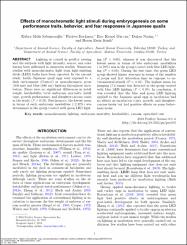| dc.contributor.author | Sabuncuoğlu, Kübra Melis | |
| dc.contributor.author | Korkmaz Turgud, Firdevs | |
| dc.contributor.author | Gürcan, Eser Kemal | |
| dc.contributor.author | Narinç, Doğan | |
| dc.contributor.author | Şamlı, Hasan Ersin | |
| dc.date.accessioned | 2022-05-11T14:42:33Z | |
| dc.date.available | 2022-05-11T14:42:33Z | |
| dc.date.issued | 2018 | |
| dc.identifier.issn | 0032-5791 | |
| dc.identifier.issn | 1525-3171 | |
| dc.identifier.uri | https://doi.org/10.3382/ps/pey105 | |
| dc.identifier.uri | https://hdl.handle.net/20.500.11776/9416 | |
| dc.description.abstract | Lighting is crucial in poultry rearing and the subjects with light intensity, source, and color having been addressed in numerous studies. Numerous studies with monochromatic light from light-emitting diode (LED) bulbs have been reported. In the current study, fertile Japanese quail eggs were exposed to a dark environment (Control) or monochromatic green (560 nm) and blue (480 nm) lighting throughout incubation. There were no significant differences in hatch weight, hatchability, total embryonic mortality, hatch time, growth performance, and slaughter-carcass traits in the study (P > 0.05). Furthermore, the lowest mean in terms of early embryonic mortalities (12.37%) was determined in the group treated with green LED light-ing (P < 0.05), whereas it was discovered that the lowest mean in terms of late embryonic mortalities (13.59%) was in the group treated with blue LED lighting (P < 0.05). During the test time, the green LED group showed higher averages in terms of the number of peeps and first defecation time as response to environmental stimuli (P < 0.05). The highest mean for jumping (7.6 times) was detected in the group treated with blue LED lighting (P < 0.05). In conclusion, it was revealed that the blue and green LED lighting applied to the Japanese quail eggs in incubation had no effects on incubation traits, growth, and slaughter-carcass traits but had positive effects on some behavioral traits. | en_US |
| dc.description.sponsorship | Scientific and Technological Research Council of Turkey (TUBITAK)Turkiye Bilimsel ve Teknolojik Arastirma Kurumu (TUBITAK) [2209-A] | en_US |
| dc.description.sponsorship | We thank the Scientific and Technological Research Council of Turkey (TUBITAK) for the financial support of this study with Project No. 2209-A. | en_US |
| dc.language.iso | eng | en_US |
| dc.publisher | Oxford Univ Press | en_US |
| dc.identifier.doi | 10.3382/ps/pey105 | |
| dc.rights | info:eu-repo/semantics/openAccess | en_US |
| dc.subject | monochromatic lighting | en_US |
| dc.subject | embryonic mortality | en_US |
| dc.subject | hatchability | en_US |
| dc.subject | carcass | en_US |
| dc.subject | open-field test | en_US |
| dc.subject | Coturnix-Coturnix-Japonica | en_US |
| dc.subject | Eggshell Microbial Activity | en_US |
| dc.subject | Body-Weight | en_US |
| dc.subject | Hatchability Performance | en_US |
| dc.subject | Chick Performance | en_US |
| dc.subject | Posthatch Growth | en_US |
| dc.subject | Embryonic Growth | en_US |
| dc.subject | Stress Responses | en_US |
| dc.subject | Broiler-Chickens | en_US |
| dc.subject | Breeder Eggs | en_US |
| dc.title | Effects of monochromatic light stimuli during embryogenesis on some performance traits, behavior, and fear responses in Japanese quails | en_US |
| dc.type | article | en_US |
| dc.relation.ispartof | Poultry Science | en_US |
| dc.department | Fakülteler, Veteriner Fakültesi, Zootekni ve Hayvan Besleme Bölümü, Genetik Ana Bilim Dalı | en_US |
| dc.authorid | 0000-0002-5462-8384 | |
| dc.identifier.volume | 97 | en_US |
| dc.identifier.issue | 7 | en_US |
| dc.identifier.startpage | 2385 | en_US |
| dc.identifier.endpage | 2390 | en_US |
| dc.institutionauthor | Narinç, Doğan | |
| dc.relation.publicationcategory | Makale - Uluslararası Hakemli Dergi - Kurum Öğretim Elemanı | en_US |
| dc.authorwosid | SAMLI, HASAN ERSIN/F-1950-2018 | |
| dc.authorwosid | Narinç, Doğan/AAG-5912-2021 | |
| dc.authorwosid | GURCAN, ESER KEMAL/ABA-4511-2020 | |
| dc.identifier.wos | WOS:000439713200016 | en_US |
| dc.identifier.pmid | 29669004 | en_US |



















